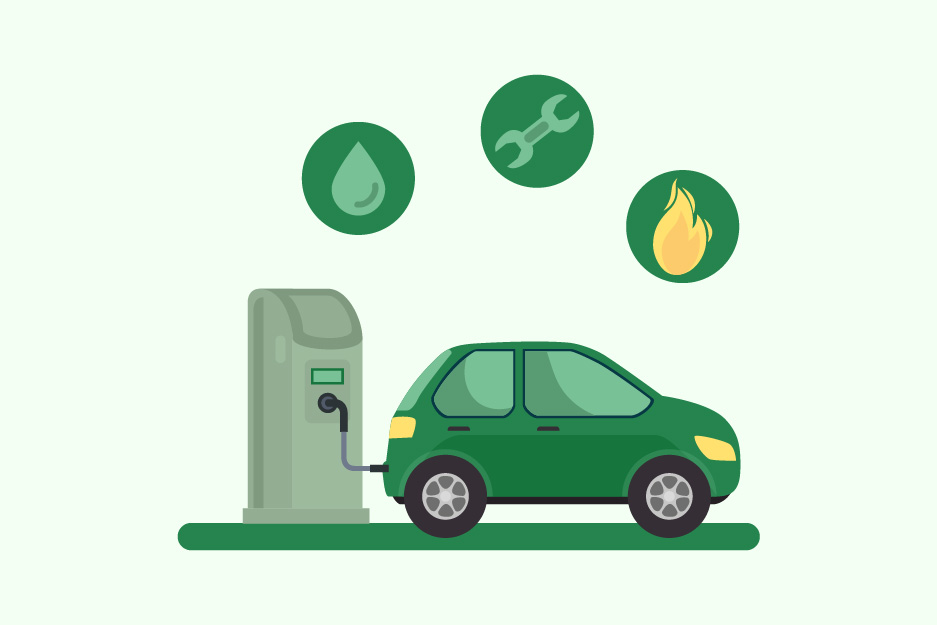Future of Electric Vehicles in India: Advancement, Pros and Cons, and More
Robert Anderson introduced electric vehicles in 1832. The transport sector has a bright future with this promising technology that promotes renewable and eco-friendly practices. EVs are experiencing an increase in evolution, and their growth is expanding immensely in the market by overtaking conventional vehicles. Electric automobiles offer us the chance to have a planet free from carbon emissions. In addition, electric vehicles could potentially offer reduced costs for maintenance and repair as opposed to traditional gas-powered cars. They also help lower reliance on fossil fuels. Let’s have a look at the future of electric vehicles in India.
What are Electric Vehicles?
Electric vehicles (EVs) are automobiles with more than one electric motor and a battery instead of fuel tanks. EVs have transformed the transportation sector by substituting conventional fuels with rechargeable battery packs.
EVs help to eliminate the dependence on fossil fuels and help move towards carbon-free footprints. Electric vehicles are environment-friendly, easy to operate, and cost-effective. EVs are considered zero-emission vehicles because they can only run on electricity and are three times more efficient than traditional vehicles. There are different types of electric vehicles such as battery electric vehicles, hybrid electric vehicles, plug-in hybrid electric vehicles, and fuel cell electric vehicles.


Future of Electric Vehicles in India
The world is rising towards net-zero carbon footprints as the adoption of EVs is increasing fast. Despite the fastest-growing sales market, EVs still remain over-priced for some buyers, and EV sales are still passive. EVs consist of less than 0.5 % of total car sales in Brazil, India, and Indonesia. By 2030, If supporting policies and investments are done correctly then sales of EVs will be doubled in multiple regions including India.
India is primarily the world’s largest consumer of two-wheeler vehicles. The current percentage of electric vehicles is comparatively low, but it is sure to increase with the dependency upon their evolution and affordability. Despite the technological advancement in electric vehicles, EVs are not considered cheaper yet. There are many factors that can change or may affect the future of electric vehicles in India.
- The government is poised to have 30% of electric vehicles by 2030, as there will be policies incorporated like infrastructure growth and tax incentives.
- The tax rates on EVs have been decreased, making them more accessible and affordable.
- The Indian automobile Industry is investing more in the production of EVs to stay competitive in the market.
- Electric two-wheelers are expected to be the most widely adopted EVs in India due to their ease of use and affordability.
- The battery is a major factor, it has a faster charging time and increased energy efficiency. They are also cheaper in comparison to fuel tanks like petrol and diesel.
- Despite many factors in advanced technologies of electric vehicles, Affordability is a key challenge, because the cost of battery replacements has significantly reduced and could be way cheaper than owning an EV in the long run.
Accelerate your career in the electric vehicle industry with our EV course with placement, offering Job assistance to launch you into the future of transportation.
Current Status of Electric Vehicles in India
According to The Ministry of Road Transport and Highways, the percentage of two-wheeler electric vehicles has risen to 422%, 75% for three-wheelers, and 230% for four-wheelers.
Among all car models available for purchase in India during 2023, only MG Comet, Tata Tiago, and Mercedes-Benz EQS were able to get high popularity among buyers. The current global situation prompts us to discuss some facts about future scope of Electic Vehicles in India and their present condition.
- EV sales are expected to grow at a CAGR of 49% between 2022 and 2030.
- In comparison to other electric vehicles, two-wheelers are becoming increasingly popular among delivery companies as well as ride-sharing companies like OLA and Uber.
There are a lot of subsidies that are being offered for electric vehicles. Following is a state-wise list of the subsidies being offered on two-wheeler electric vehicles.
| State | Subsidy (Per kWh) | Maximum subsidy | Discount on road tax |
|---|---|---|---|
| Maharashtra | Rs. 5,000 | Rs. 25,000 | 100% |
| Meghalaya | Rs. 10,000 | Rs. 20,000 | 100% |
| Gujarat | Rs. 10,000 | Rs. 20,000 | 50% |
| Assam | Rs. 10,000 | Rs. 20,000 | 100% |
| Bihar | Rs. 10,000 | Rs. 20,000 | 100% |
| West Bengal | Rs. 10,000 | Rs. 20,000 | 100% |
| Rajasthan | Rs. 2,500 | Rs. 10,000 | NA |
| Odisha | NA | Rs. 5,000 | 100% |
| Uttar Pradesh | Nil | Nil | 100% |
| Kerala | Nil | Nil | 50% |
| Karnataka | Nil | Nil | 100% |
| Tamil Nadu | Nil | Nil | 100% |
| Telangana | Nil | Nil | 100% |
| Madhya Pradesh | Nil | Nil | 99% |
| Andhra Pradesh | Nil | Nil | 100% |
| Punjab | Nil | Nil | 100% |
The subsidy offered on four-wheeler cars is as follows:
| State | Subsidy (Per kWh) | Maximum subsidy | Discount on road tax |
|---|---|---|---|
| Maharashtra | Rs. 5,000 | Rs. 2,50,000 | 100% |
| Meghalaya | Rs. 4,000 | Rs. 60,000 | 100% |
| Gujarat | Rs. 10,000 | Rs. 1,50,000 | 50% |
| Assam | Rs. 10,000 | Rs. 1,50,000 | 100% |
| Bihar | Rs. 10,000 | Rs. 1,50,000 | 100% |
| West Bengal | Rs. 10,000 | Rs. 1,50,000 | 100% |
| Rajasthan | Nil | Nil | NA |
| Odisha | NA | Rs. 1,00,000 | 100% |
| Uttar Pradesh | Nil | Nil | NA |
| Kerala | Nil | Nil | 50% |
| Karnataka | Nil | Nil | 100% |
| Tamil Nadu | Nil | Nil | 100% |
| Telangana | Nil | Nil | 100% |
| Madhya Pradesh | Nil | Nil | 99% |
| Andhra Pradesh | Nil | Nil | 100% |
| Punjab | Nil | Nil | 100% |


Technology Advancement in Electric Vehicles
Electric vehicles have been around since the 1830s. Its growth has advanced rapidly since its production. Today, there are many battery vehicles and plug-in hybrid options available in the market. Advancement in technology is the crucial phase where things gear up with more user-friendly, convenient, and easy-to-use. The same applied to EVs as well.
Let’s take a dive into the advancement of EVs:
- EVs are very commonly used and built-in with advanced self-driving technology. The self-driving electric vehicles are very easy to use which makes them more convenient.
- The battery market for electric vehicles has been significantly improved with more affordability. With the advancement in battery technologies, automotive companies prefer using solid-state batteries instead of lithium-ion batteries. Solid-state batteries are much safer and lighter than lithium-ion batteries and have longer battery life.
- Thousands of cells make up EV batteries. The battery becomes unusable for electric vehicles when cells degrade enough. Those batteries can experience a renewed lifespan thanks to smart battery management technology, several EV batteries can act as a single, larger battery. Storing energy locally from the grid or green power sources can be done using this large battery.
- Public charging infrastructure has also been changed, as the electric charging infrastructure has been the backbone of automobile companies.
- EVs have been more accessible with innovative solutions like bidirectional charging systems and wireless charging pads.
Pros and Cons of Electric Vehicles
Pros
The pros of using an electric vehicle are as follows-
- Electric vehicles play a major role in driving a greener future and reducing reliance on fossil fuel dependency.
- Solid-state batteries are safer and much lighter in weight and have longer battery life.
- EVs are affordable and free of fuel tanks and have the potential for self-driving capabilities.
- In comparison to other conventional vehicles, EVs provide a much quieter and smoother ride.
- EVs are faster than other traditional gasoline-powered vehicles.
Cons
The cons of using an electric vehicle are as follows-
- The high upfront cost of EVs can be a barrier for people to afford.
- There are limited charging stations, as compared to gas stations. This can become a problem if you’re traveling for a longer distance.
- The battery of EVs needs to be replaced after several years of use.
- Electric vehicles have a limited charging range. Generally, it can go up to 300 miles on a single charge.
Conclusion
The future of electric vehicles in India looks promising as the government aims to focus on a carbon-free footprint and a greener future. They are environment-friendly, easy to operate, and cost-effective. Despite some challenges, the benefits outweigh them.







